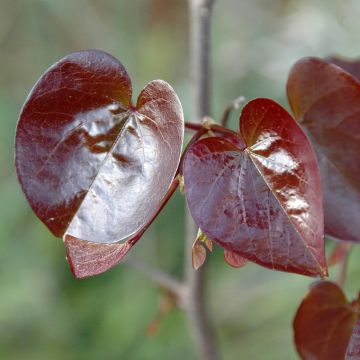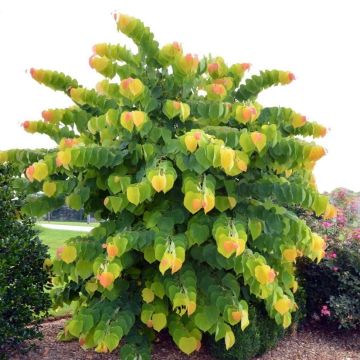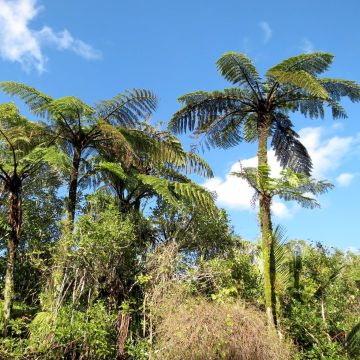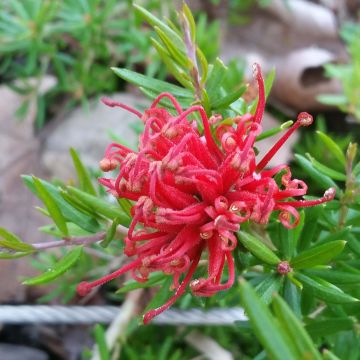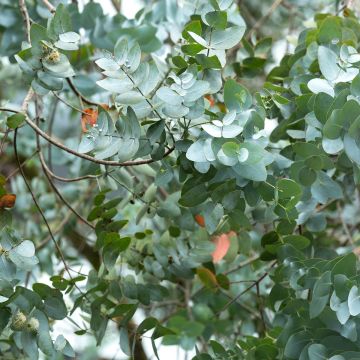

Cercis canadensis Ruby Falls - Eastern Redbud


Cercis canadensis Ruby Falls - Eastern Redbud
Cercis canadensis Ruby Falls - Eastern Redbud
Cercis canadensis Ruby Falls
Eastern Redbud, Canadian Redbud, American Redbud, Judas Tree
I received my cercis canadensis "Ruby Falls" just a few days ago, and I am very satisfied with it so far. It has a straight stem, which is just under 2 meters (7 feet) tall, and the top of this stem has 2 pendulous branches, symmetrical and well-shaped, which makes an excellent starting form. I should note that the specimen would have measured 2m (7ft) tall or even a bit more if the small top, which was sticking out, hadn't been broken during transportation... but it's not a big deal because I cleanly cut off the broken area, at an angle, and I think a new top will grow from there. But anyway, the current size of the bush suits me perfectly, considering the use I intend for it, which is to plant it at the base of my Acer platanoïdes "Princeton Gold" (Norway maple) on a stem, so that its pendulous branches nicely adorn the trunk of this beautiful golden maple. Additionally, this will create a contrast of colors (gold vs. burgundy, then golden yellow vs. amber orange in autumn), habits (the upright habit of the maple vs. the pendulous habit of the cercis), and foliage (the "traditional" shape of the maple leaf, large in this variety, vs. the heart-shaped leaves of the cercis, which are also large). At the beginning of the season, the flowering of this cercis (purplish pink) contrasted with that of the maple (yellow) will also create a beautiful spring scene... Finally, for enthusiasts of vibrant colors, this cercis can be paired with the varieties "Golden Falls" (with very large golden foliage) and "Eternal Flame" (predominantly orange)... which creates a bordeaux/golden/orange composition that is highly interesting, especially considering that it doesn't take up much space on the ground, given the modest size of these bushes.
Rebecca, 25/12/2022
This item cannot be shipped to the selected country
Oversize package delivery charge from €6.90
Delivery charge from €5.90
Delivery to Corse prohibited
More information
Schedule delivery date,
and select date in basket
This plant carries a 24 months recovery warranty
More information
We guarantee the quality of our plants for a full growing cycle, and will replace at our expense any plant that fails to recover under normal climatic and planting conditions.
Oversize package: home delivery by special carrier from €6.90 per order..
Express home delivery from €8.90.
From €5.90 for pickup delivery and €6.90 for home delivery
Express home delivery from €8.90.
Delivery to Corse prohibited: UE law prohibits the import of this plant from mainland France to Corse as part of the fight against Xylella fastidiosa. Please accept our sincere apologies.
More information


Does this plant fit my garden?
Set up your Plantfit profile →
Description
Cercis canadensis 'Ruby Falls' is a recent variety of Eastern Redbud, still not very common in our gardens. This small bush is one of the most beautiful in its genus and its small size allows it to be adopted even when space is limited, either in the ground or on a sunny terrace. It is a dwarf and very weeping form of the famous cultivar 'Forest Pansy'. In spring, its flowering adorns the trunk and bare branches with pinkish-purple pea-like flowers, just before the emergence of translucent red young shoots that unfold into purple and glossy leather-like leaves. This wonderful deciduous shrub is also very accommodating, as long as the soil it is planted in is not too dry.
'Ruby Falls' belongs to the Fabaceae family. The type species is native to eastern and central United States. Its growth is rather slow and its size after 10 years will not exceed 2 m (6.6 ft) in height and 1 m (3.3 ft) in width. It is a small tree with a very weeping habit, with branches that droop towards the ground. The flowers appear before the leaves, in March-April, directly on the branches and even on the trunk. Flowers will even bloom on branches that are only 1 year old. They are pea-like flowers, lavender-pink in colour. The fruits, in the form of flattened pods, are rarely present on this variety. Foliage emerges red and translucent, then intensively turns into a shiny purple colour, turning to dark green in summer, with shaded leaves being more distinctly green. The leaves are heart-shaped, 10 cm (3.9 in) long, quite thick and glabrous. The young branches are also purple, while the older branches have a fissured grey-black bark. Mature specimens often have a twisted trunk and a 'parasol' canopy, giving them a very Japanese silhouette.
It forms a unique and attractive shrub almost all year round. It takes up little space and has a strong personality, adding a unique touch to a small garden or in the centre of a large bed. It only requires fairly deep soil, regardless of its nature, even limestone. It is very hardy, and does not require any particular pruning: in short, it is a very accommodating plant that can thrive in any garden!
Cercis canadensis 'Ruby Falls' can be planted as a standalone specimen for its year-round presence, especially in a space dominated by mineral elements, surrounded by large rock stones. An older specimen, carefully trained in an 'umbrella' shape on a sinuous trunk, could also make a good impression on a carpet of Mascarene grass (Zoysia tenuifolia), standing in the middle of a small Japanese scene. It is also easy to imagine it standing out against the background of a wall or evergreen foliage, accompanied by Elderberry 'Plumosa aurea' and Ceanothus 'Concha' for colour and shape contrast, with a few Darley Heath and hellebores for winter! You could even consider planting it with a dwarf winged Euonymus and a beautiful 'Grace' Smokebush for perfectly colourful scenes.
Report an error about the product description
Cercis canadensis Ruby Falls - Eastern Redbud in pictures




Plant habit
Flowering
Foliage
Botanical data
Cercis
canadensis
Ruby Falls
Fabaceae
Eastern Redbud, Canadian Redbud, American Redbud, Judas Tree
Cultivar or hybrid
Other Cercis
Planting and care
Cercis canadensis 'Ruby Falls' is happy in the sun, as long as it is not scorching. It will also accept partial shade. It is not very demanding on the nature of the soil, as long as it is deep and retains moisture. In poor soil, enrich it with good compost or potting soil. Water it regularly during the first seasons in case of drought, as it fears excessive drying out. It tolerates all types of soil but prefers neutral or acidic soils. It is perfectly hardy, but young shoots may suffer in case of severe frost in early spring. Protection with winter fleece can be useful in the first years in case of a severe cold snap in March.
Planting period
Intended location
Care
-
, onOrder confirmed
Reply from on Promesse de fleurs
Striking foliage shrubs
Haven't found what you were looking for?
Hardiness is the lowest winter temperature a plant can endure without suffering serious damage or even dying. However, hardiness is affected by location (a sheltered area, such as a patio), protection (winter cover) and soil type (hardiness is improved by well-drained soil).

Photo Sharing Terms & Conditions
In order to encourage gardeners to interact and share their experiences, Promesse de fleurs offers various media enabling content to be uploaded onto its Site - in particular via the ‘Photo sharing’ module.
The User agrees to refrain from:
- Posting any content that is illegal, prejudicial, insulting, racist, inciteful to hatred, revisionist, contrary to public decency, that infringes on privacy or on the privacy rights of third parties, in particular the publicity rights of persons and goods, intellectual property rights, or the right to privacy.
- Submitting content on behalf of a third party;
- Impersonate the identity of a third party and/or publish any personal information about a third party;
In general, the User undertakes to refrain from any unethical behaviour.
All Content (in particular text, comments, files, images, photos, videos, creative works, etc.), which may be subject to property or intellectual property rights, image or other private rights, shall remain the property of the User, subject to the limited rights granted by the terms of the licence granted by Promesse de fleurs as stated below. Users are at liberty to publish or not to publish such Content on the Site, notably via the ‘Photo Sharing’ facility, and accept that this Content shall be made public and freely accessible, notably on the Internet.
Users further acknowledge, undertake to have ,and guarantee that they hold all necessary rights and permissions to publish such material on the Site, in particular with regard to the legislation in force pertaining to any privacy, property, intellectual property, image, or contractual rights, or rights of any other nature. By publishing such Content on the Site, Users acknowledge accepting full liability as publishers of the Content within the meaning of the law, and grant Promesse de fleurs, free of charge, an inclusive, worldwide licence for the said Content for the entire duration of its publication, including all reproduction, representation, up/downloading, displaying, performing, transmission, and storage rights.
Users also grant permission for their name to be linked to the Content and accept that this link may not always be made available.
By engaging in posting material, Users consent to their Content becoming automatically accessible on the Internet, in particular on other sites and/or blogs and/or web pages of the Promesse de fleurs site, including in particular social pages and the Promesse de fleurs catalogue.
Users may secure the removal of entrusted content free of charge by issuing a simple request via our contact form.
The flowering period indicated on our website applies to countries and regions located in USDA zone 8 (France, the United Kingdom, Ireland, the Netherlands, etc.)
It will vary according to where you live:
- In zones 9 to 10 (Italy, Spain, Greece, etc.), flowering will occur about 2 to 4 weeks earlier.
- In zones 6 to 7 (Germany, Poland, Slovenia, and lower mountainous regions), flowering will be delayed by 2 to 3 weeks.
- In zone 5 (Central Europe, Scandinavia), blooming will be delayed by 3 to 5 weeks.
In temperate climates, pruning of spring-flowering shrubs (forsythia, spireas, etc.) should be done just after flowering.
Pruning of summer-flowering shrubs (Indian Lilac, Perovskia, etc.) can be done in winter or spring.
In cold regions as well as with frost-sensitive plants, avoid pruning too early when severe frosts may still occur.
The planting period indicated on our website applies to countries and regions located in USDA zone 8 (France, United Kingdom, Ireland, Netherlands).
It will vary according to where you live:
- In Mediterranean zones (Marseille, Madrid, Milan, etc.), autumn and winter are the best planting periods.
- In continental zones (Strasbourg, Munich, Vienna, etc.), delay planting by 2 to 3 weeks in spring and bring it forward by 2 to 4 weeks in autumn.
- In mountainous regions (the Alps, Pyrenees, Carpathians, etc.), it is best to plant in late spring (May-June) or late summer (August-September).
The harvesting period indicated on our website applies to countries and regions in USDA zone 8 (France, England, Ireland, the Netherlands).
In colder areas (Scandinavia, Poland, Austria...) fruit and vegetable harvests are likely to be delayed by 3-4 weeks.
In warmer areas (Italy, Spain, Greece, etc.), harvesting will probably take place earlier, depending on weather conditions.
The sowing periods indicated on our website apply to countries and regions within USDA Zone 8 (France, UK, Ireland, Netherlands).
In colder areas (Scandinavia, Poland, Austria...), delay any outdoor sowing by 3-4 weeks, or sow under glass.
In warmer climes (Italy, Spain, Greece, etc.), bring outdoor sowing forward by a few weeks.


































